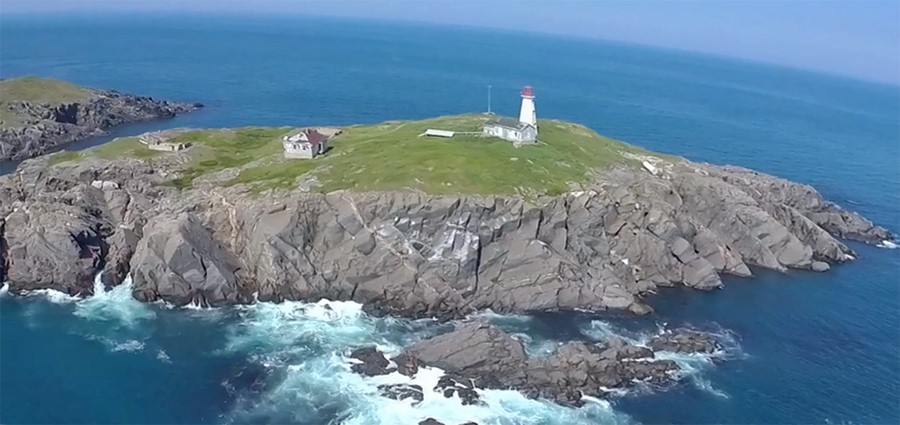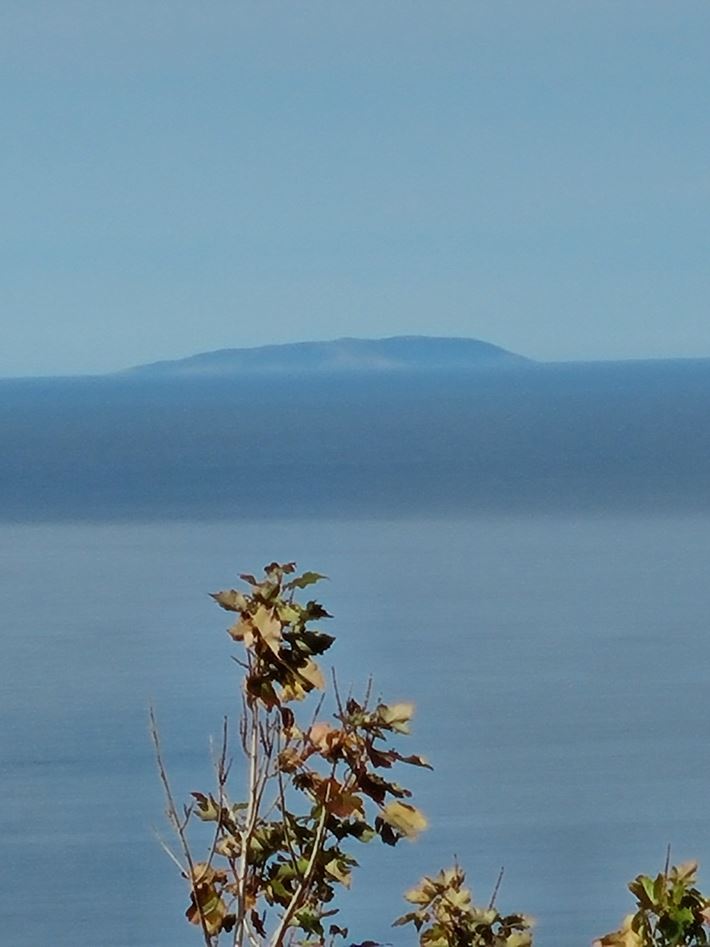(View of St. Paul Island from White Point Rd, Victoria County)
Twenty-four kilometres off the northern tip of Cape Breton lies a silent, ominous island named St. Paul. This small piece of land is approximately 4.8 km (3 miles) wide and 1.6 km (1 mile) long. It remains uninhabited; home only to many birds along with some rare vegetation not found elsewhere in Nova Scotia. The trees grow only a few years before falling over from the high winds creating a densely wooded inland. The highest point on the island is atop Croggan Mountain at 147 metres (485 ft) and it’s an extension of the Appalachian Mountains. The coastline surrounding St. Paul is rugged with rock-face cliffs. There are only two spots climbable with effort onto the island coming by water.

(photo credit: www.lighthousefriends.com)
Although the island is quite small, it has been a formidable obstacle between the Cabot Strait and the Gulf of St. Lawrence. Due to its location, it’s subject to variable and powerful water currents and sudden, unpredictable weather changes that include violent winds upwards of 160 km winds with very dense fog conditions. This has led to at least 350 shipwrecks and the loss of thousands of lives. It has been aptly nicknamed “The Graveyard of the Gulf.” Many of these shipwrecks took place before lighthouses (1834) and lifesaving stations (1831) were put in place. One such wreck, the Jessie, spurred the call to do something about it.
The Jessie, a three masted barque, left Charlottetown on December 24, 1824, setting sail for Liverpool, England. She got caught in a blinding snowstorm sending her straight into St. Paul Island on January 1, 1825. Of the 27 passengers and crew aboard, 23 fought their way through stormy conditions in icy waters and somehow managed the steep climbs up the cliffs onto St. Paul Island. They salvaged whatever supplies they could from the ship and they made a makeshift shelter possibly out of pieces of the wreck. They made fires to keep warm and conceivably to signal to Cape Breton or passing vessels that they were stranded. Winter conditions on this isolated island can be harsh and callous. There are no animals to hunt for food, no plants to eat at this time of year and very little shelter from the wind and snow in the stunted trees. The survivors were left to their own devices. They endured 11 gruelling weeks during the bitter and bleakest time of year on the island. The captain, Donald MacKay, kept a journal of the hardships and their fight to survive. Unfortunately, all 23 lost that fight to survive. MacKay’s final entry was March 17, 1825, in which he states that he is the last living survivor. One can only imagine how gruelling and painful those weeks were.
Back in Charlottetown, no one knew the fate of the Jessie until one day in the spring, a French sealer was in town. He was apprehended by Mrs. MacKay who noticed he was wearing her dead husband's coat. She asked to see inside the coat to confirm that it was in fact Donald’s. Inside the coat, hand-sewn by Mrs. MacKay herself, was Donald MacKay’s initials. A vessel from Cheticamp set sail to recover the bodies. The captain and a few others were returned to Charlottetown but the rest were buried where they were found.
Oftentimes fires could be seen from the mainland from shipwreck victims during the winter months, but due to icy conditions no vessels could come to the rescue. Ships from Cape Breton would then set sail in Spring to collect and bury the bodies. And unfortunately, to pillage from the lost souls, as in the case of Donald MacKay.
Jessie’s Cove, on the southwest point of St. Paul Island, is named in honour of the wreck. There are countless other tragedies both from shipwrecks and accidents occurring on the island to lighthouse keepers and their families. Many of the coves of the island are in fact named after shipwrecks. There is an air of mystery surrounding St. Paul Island. Hundreds of years of tragic events, thousands of lives lost and many marked and unmarked graves on and surrounding the island and yet it remains mostly unknown to the general public. A mystery indeed.





3
Log In or Sign Up to add a comment.- 1
arrow-eseek-e1 - 2 of 2 itemsFacebook Comments